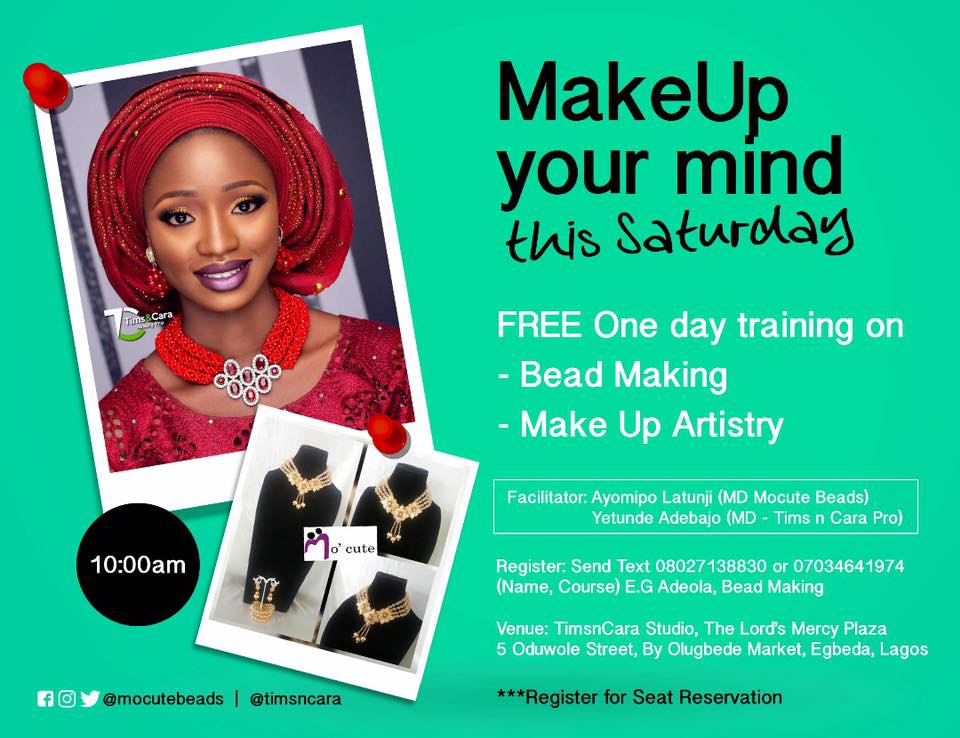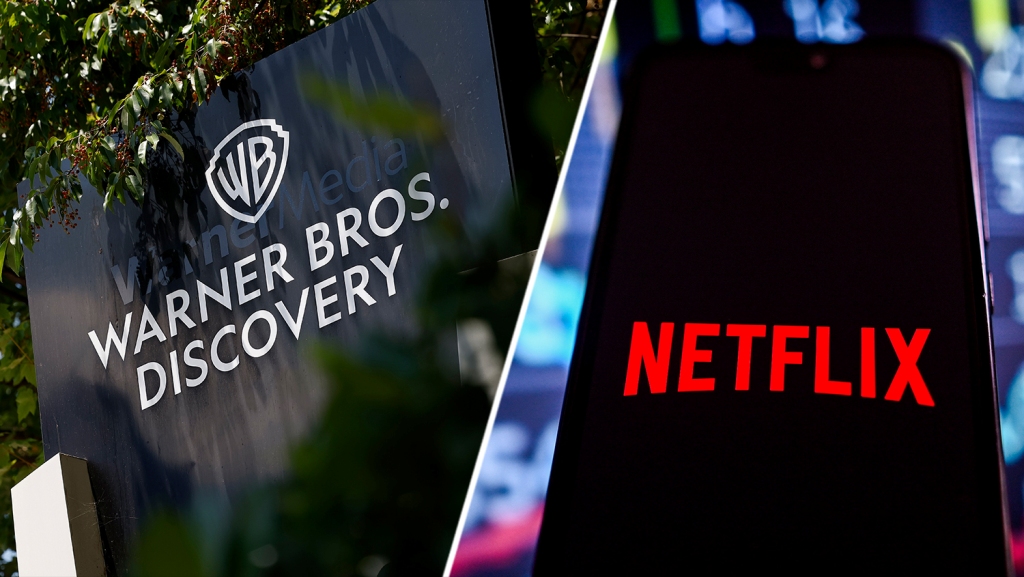Brands/Products
Things to Consider When Setting Up A Make-Up Business

By Adedapo Adesanya
The beauty industry is one of the most promising and profitable enterprises for any one to invest their money in, especially in a country like Nigeria where there is a litany of events from weddings to birthdays to funerals and others.
It is also a business that has many uses and not majorly for entertainment or ceremonial functions. Other opportunities include makeup for films and TV, for music videos, stage plays, television shows and advertisements and making models up to create specific impressions on the runaway.
But before starting this profitable venture, there are some things you must consider or else, you might not be able to achieve any meaningful thing from the business. These key items are highlighted below:
Skill
This is the most important thing for a make up artiste to have. It is considered an art, and in the instance that the person who wants to start the make up business has no skill, but possesses passion, the first step will be skill acquisition for the aspiring make up artist.
Acquiring a wide range of skill can be done through many outlets. It may involve training as an apprentice under a professional or even acquiring the skill by volunteering as an intern in a reputable make up studio.
Nowadays, the Nigerian government has created several skill acquisition and empowerment programmes to it makes it possible for anyone to learn at a lesser cost or none at all.
According to the specialists contacted by Business Post, they recommend that the best way to learn the art of make up would be to serve as an apprentice under a professional. This, they echoed, will make them see first hand how it is done and also, in the instance of offsite jobs, they get to learn other areas of make up such as bridal makeover and model makeover.
Capital
With the skill acquired, entry into the make-up business requires money and considering the major tools used by make up artists, a standard capital for establishing a make up business is N100,000, which will be mostly spent on acquiring quality makeup kits. With the necessary capital acquired, the make up artiste may not really need a studio yet because at the beginning, he or she can always always work from home and as time goes on with the business expanding, a studio can be acquired later on.
But in the instance of availability of funds to rent a studio, he or she might rent a small space. With shop prices going for a low as N5,000 per month, a fair rent price for a year including agent agreement and other fees settled may culminate at N150,000, and adding the makeup equipment, this may extend to a standard capital of N250,000.
Studio
Setting up a lucrative make up business may involve the practitioner to own a studio or not, but having a studio is a plus because this allows the customers a physical location to visit and it adds a kind professionalism to the business. The studio is where the make up artist receives their clientele, train their apprentices, and handle other businesses.
Location
In the instance that the make up artiste has a studio, it is advisable that it should be located where it can be seen and reached with ease.
Make-up Tools and Uses
Makeup equipment for starting up a makeup business are the tools that the artist makes use of, they exist in various price ranges but for the entrepreneur willing to set up from scratch, the equipment and their prices have been adjusted to prices set following the Trade Fair market price, where a large cosmetic market is located and purchases can be made by the make up artist.
Brush Set: Used to lay foundations and apply concealers – N5,000.
Foundations: In several shades, used on the face to the tone of the clients body before proceeding to apply powder (at least five shades) at N1,500 per shade × 5 – N7,500.
Powder palettes: Matches the skin to correcting any skin issues the client may be concerned about – N6,000.
Eye shadow palettes: Different colours applied on the eyelids and under the eyes. It is commonly used to make the client’s eyes stand out or look more attractive – N3,000.
Face primer: This is a base for foundation or face makeup that allows it to go on smoother and also last longer. – N2,000.
Eyeshadow primer: It helps eye-shadow stay put and creates long- lasting vibrant color. – N1,500.
Many shades of lipsticks: Particularly red, nude, pink and purple: applied on the lips – N2,000 for a pack.
Bronzers: Used to darken areas of the skin without masking it, or to add warmth. Used to make the client’s skin look radiant and healthy – N1,500.
Blush: For coloring the cheeks in varying shades – N1,000.
Concealer palette for different shade types: Used to mask dark circles, age spots, and other small blemishes visible on the skin. It is similar to foundation, but thicker and used to hide different pigments by blending the imperfection into the surrounding skin tone – N1,000.
Set of Lashes: Artificial lashes used to beautify the face – N1,000 (for a set of eight lashes).
Lash glue: For holding the eye lashes in place. – N500 (per tube).
Contour palette: To shape the face – N1,000.
Face wipes: For wiping off dirt and make up – N500.
Eye, Brow and Lip Pencils: For shaping the brows and lips to desired structure – N1,000.
Mascara: Used to enhance the eyelashes. It may darken, thicken, lengthen, and/or define the eyelashes – N500.
Setting powder: Helps to keep your makeup in place all day long. – N2,000.
Setting spray: To keep makeup in place for hours at a time. – N1,000.
Glitters /Pigments: Used in special cases to make faces look shiny – N2,000.
Makeup Bag: This is where all make up equipment are kept, it must be spacious and long lasting – N15,000.
Cape: used to cover the client’s body when the make up artist is working – N1,000 (full-length)
Ring Light (optional): used to lighten the face of the client for photographic effect purposes – N7,000.
Foldable Makeup Chair – N36,000
Total = N99,000.
Marketing/Advertising
With the capital utilised to set up the studio and the make-up equipment acquired. It is important to get customers and the beauty industry is a very competitive space. Hence, the make up artist needs to think a step ahead.
The Internet is a very affordable advertising space. With social network platforms like Instagram, Twitter, and Facebook, the brand can reach others. Marketing can also be done by offering free makeup to people of influence who can then spread the word. Also, the make-up artist can start by posting pictures of her jobs on social media platforms and tags friends to help spread the images.
Registering the Company
It is important for a makeup artist to register the business to give it a corporate look. This can be done for less than N20,000 with the Corporate Affairs Commission (CAC). Doing this will help the practitioner open a corporate account for corporate jobs.
Carving A Niche in the Make up Business
For every make up artiste in the business, it is important to create something different from what others do. To render the service in a way that gives him or her a comparative advantage against competitors. This helps retain customers and expand the business.
If you require further information, feel free to use the comment section below this article. We will get experts in the industry to give adequate answers to your questions.
Brands/Products
Lafarge Africa Debuts Beyond Buildings Campaign

By Adedapo Adesanya
Top building materials and solutions brand, Lafarge Africa Plc, has unveiled a new thematic campaign tagged Beyond Buildings geared towards highlighting its impact and contributions to Nigeria’s infrastructural development.
The campaign was unveiled by the chief executive of Lafarge Africa, Mr Lolu Alade-Akinyemi, on Monday, December 8, 2025, in Lagos.
Mr Alade-Akinyemi noted that the campaign highlights how Lafarge, through innovative and sustainable building solutions, has continued to shape the socio-economic development and progress of Nigerians and Nigeria by contributing to the construction of various structures, including iconic buildings and bridges, stadiums, hospitals, roads, and more, ultimately aiding the nation’s overall growth.
“For over six decades, beyond the manufacturing of building solutions, we have partnered in building the very foundation of Nigeria’s infrastructural development and its future. With our innovative solutions, we have made a significant contribution to our nation’s progress by providing essential building materials for numerous landmark projects.
“This also extends to the expansion of our production capacity nationwide, creating jobs and livelihoods, bringing development to communities, and introducing innovative products to meet the ever-evolving construction needs of Nigeria,” he said.
He described the campaign as a celebration of strength, innovation, history, shared success, and the power of progress, noting that it is the story of the company’s humble beginnings, which dates back to 1960 when its first factory began production.
“The Beyond Buildings campaign is the story of our vision, which is to be the leading building solutions company, driving innovation and operational excellence to create a greener planet and enable national progress. It shifts the narrative from our products to the profound impact we make on human lives. Our materials transform into national landmarks, powering jobs, livelihoods, and development across every state,” he noted.
The thematic campaign Beyond Buildings spotlights how Lafarge has been a strong and steady partner in building infrastructure that underpins Nigeria’s socio-economic progress.
“We are celebrating our enduring legacy and committing to a new era of sustainable and innovative growth. This campaign empowers us to tell that story with confidence and clarity,” he added.
Delivering his remarks, the Commercial Director of Lafarge Africa, Mr Gbenga Onimowo, stressed that the premiere viewing is an opportunity to share the compelling reasons why the company’s story, ‘Beyond Buildings,’ must be told.
Mr Onimowo stated that the campaign aims to reinforce the company’s position at the heart of Nigeria’s construction growth since independence, as demonstrated by its extensive footprint of infrastructure development across every corner of the country.
‘However, our contribution is not merely about building solutions including cement, mortar, plaster of paris and readymix concrete. It’s about the shared future and the national development we actively enable,’ he said.
He stated that the campaign was designed to move the conversation past the physical structures and shine a light on the socio-economic impact that the company helps create.
“Our campaign highlights the immense progress built on the concrete of trust since 1960. Our materials are integral to iconic landmarks like the National Theatre, 1st and 2nd Niger Bridges, Third Mainland bridge, Lekki-Ikoyi link bridge, the National Assembly Complex and countless national, commercial, academic and residential structures nationwide,” he added.
The event was well attended by distinguished stakeholders from the building and construction sector as well as the arts, culture, media and entertainment industry, alongside many of the company’s esteemed customers including veteran Nollywood actors Richard Mofe-Damijo (RMD) and Kate Henshaw.
Brands/Products
X3M Ideas Emerges Agency of the Year at LAIF 20th Anniversary

By Modupe Gbadeyanka
The prestigious Agency of the Year title has been clinched by X3M Ideas, a foremost integrated marketing communications (IMC) firm in Africa, at the Lagos Advertising and Ideas Festival (LAIF) Awards.
LAIF rolled out drums to celebrate its 20th anniversary at the Marriott Hotel, GRA Ikeja, Lagos, on Sunday, November 30, 2025.
The award ceremony, themed 20 Years of Crazy, was attended by several stakeholders in the IMC sector in the country.
At the event, X3M Ideas, established by a veteran in the industry, Mr Steve Babaeko, topped the medal table with 12 Gold, 20 Silver, and 24 Bronze awards, totalling 336 points. The second and third-placed agencies scored 153 and 141 points, respectively.
In 2023, X3M Ideas achieved a similar feat at LAIF and also emerged African Agency of the Year at the 2023 and 2024 editions of the African Cristal Awards.
During this period, Mr Babaeko was named African Personality of the Year, reaffirming the agency’s position as a leader in the African advertising industry.
The 2025 edition of LAIF was also a double celebration for X3M Ideas, as Mr Babaeko, alongside other industry leaders, received special recognitions and commemorative plaques for their invaluable contributions to establishing LAIF as West Africa’s premier creative showcase.
“We are extremely excited to win again at LAIF. This achievement demonstrates how we have continuously evolved, innovated, and remained creative, going ‘crazy’, in line with the theme of the award, by turning every brief into campaigns that resonate across all ages.
“This win also signifies that, together whether as individuals, agencies, or brands, we can shape the future of advertising, push boundaries, and redefine excellence,” Mr Babaeko, who is the Chief Creative Officer of X3M Ideas, said.
Recall, X3M Ideas broke a 70-year jinx to become the first Nigerian and West African agency to win at the Cannes Lions International Festival of Creativity.
The agency continues to put Nigeria on the global map, winning notable awards at the 2024 Lisbon International Advertising Festivals Group.
Additionally, X3M Ideas was recognised as one of Africa’s fastest-growing companies for 2025 by the Financial Times, ranked 31st among 130 companies across the continent.
Its campaign, Blood Sacrifice, also won at the 2025 Cannes Lions Festival, earning top honours at the prestigious ACT Responsible exhibition.
LAIF was established through the bold vision of the Association of Advertising Agencies of Nigeria (AAAN) to celebrate and elevate creativity within Nigeria’s marketing communications industry.
Brands/Products
Netflix to Buy Warner Bros. Discovery in $82.7bn Mega Deal

By Adedapo Adesanya
Netflix has reached a deal with Warner Bros. Discovery to buy the legendary TV and movie studio and assets like the HBO Max streaming service for $82.7 billion.
Warner Bros. Discovery is moving forward with its plans to split into two publicly traded halves in 2026. Once the split takes effect, Netflix intends to acquire the Warner Bros. half. The other half, Discovery Global, will house CNN and other cable channels. The Warner Bros. half includes its film and television studios, HBO Max and HBO.
The transaction values Warner Bros. Discovery at $27.75 per share, implying a total equity value of approximately $72.0 billion and an enterprise value of approximately $82.7 billion.
The deal is subject to regulatory conditions, of which there will be several, due to the size of the companies involved and what it means for competitiveness.
For several weeks, Paramount was thought to be the frontrunner in the auction for Warner Bros. Discovery. Paramount executives, who want to buy all of Warner Bros. Discovery – including its cable assets – were confident about their merger proposal and their mutually beneficial relationship with President Donald Trump.
However, Netflix surprised many with the boldness of its bids as it agreed to the same costly breakup fee that Paramount proposed, according to reports. This means the would-be buyer will pay Warner Bros. Discovery billions of dollars if the deal is not completed.
“Our mission has always been to entertain the world,” said Mr Ted Sarandos, co-CEO of Netflix. “By combining Warner Bros.’ incredible library of shows and movies—from timeless classics like Casablanca and Citizen Kane to modern favorites like Harry Potter and Friends—with our culture-defining titles like Stranger Things, KPop Demon Hunters and Squid Game, we’ll be able to do that even better. Together, we can give audiences more of what they love and help define the next century of storytelling.”
Mr Greg Peters, the other co-CEO of Netflix, said the acquisition would “improve our offering and accelerate our business for decades to come,” adding: “Warner Bros. has helped define entertainment for more than a century and continues to do so with phenomenal creative executives and production capabilities. With our global reach and proven business model, we can introduce a broader audience to the worlds they create—giving our members more options, attracting more fans to our best-in-class streaming service, strengthening the entire entertainment industry and creating more value for shareholders.”
“Today’s announcement combines two of the greatest storytelling companies in the world to bring to even more people the entertainment they love to watch the most,” said David Zaslav, President and CEO of Warner Bros. Discovery. “For more than a century, Warner Bros. has thrilled audiences, captured the world’s attention, and shaped our culture. By coming together with Netflix, we will ensure people everywhere will continue to enjoy the world’s most resonant stories for generations to come.”
The terms of the agreement will see each Warner Bros. Discovery shareholder receive $23.25 in cash and $4.50 in shares of Netflix common stock for Warner Bros. Discovery common stock share.
-

 Feature/OPED6 years ago
Feature/OPED6 years agoDavos was Different this year
-
Travel/Tourism9 years ago
Lagos Seals Western Lodge Hotel In Ikorodu
-

 Showbiz3 years ago
Showbiz3 years agoEstranged Lover Releases Videos of Empress Njamah Bathing
-

 Banking7 years ago
Banking7 years agoSort Codes of GTBank Branches in Nigeria
-

 Economy3 years ago
Economy3 years agoSubsidy Removal: CNG at N130 Per Litre Cheaper Than Petrol—IPMAN
-

 Banking3 years ago
Banking3 years agoFirst Bank Announces Planned Downtime
-

 Banking3 years ago
Banking3 years agoSort Codes of UBA Branches in Nigeria
-

 Sports3 years ago
Sports3 years agoHighest Paid Nigerian Footballer – How Much Do Nigerian Footballers Earn













2 Comments